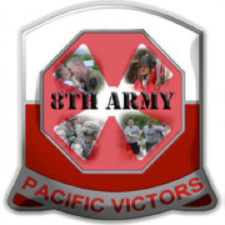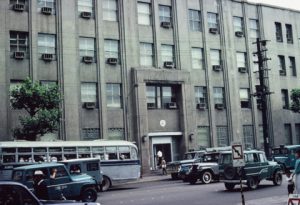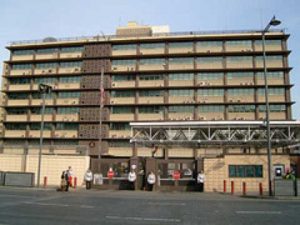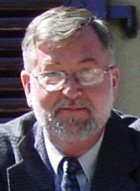by Dr. John Handley, Vice-President of American Diplomacy Publishers
We have featured many strange and interesting stories in our Foreign Service Life section but this one may be among the most unusual and disturbing ones we have published. We wonder if there are any other similar instances of inter-agency intrigue at Embassies abroad? –Ed.
 A few weeks into my tour I received a call from the commanding general’s (CG) secretary summoning me to his office. I reported, saluted, and stood at attention until given the command “at ease.” The CG told me that the U. S. Ambassador to South Korea, Philip Habib, was an important member of the country team, and as such Ambassador Habib needed access to compartmented intelligence. For reasons the CG did not understand, or at least care to explain, the CIA within the U. S. Embassy had denied the ambassador access to classified material. Since the two Koreas had signed an armistice and were technically still at war, the highest-ranking U. S. military officer in country ran the country team. The U. S. Ambassador held “the number two” position. The CG told me it was imperative that Ambassador Habib had access to the same classified intelligence that he and his 8th Army staff had, thus I was to take a driver and vehicle as well as a weapon, along with the weekly written intelligence briefing, to the embassy and deliver it to Ambassador Habib every Friday at 1000. The general’s additional instructions included: ensure the room was clear of everyone except the ambassador; provide a piece of paper for the ambassador to write any questions he might have; write the answers to his questions if I knew them or arrange to return with the answers at a later date; secure any written questions and answers before departing. As I was about to depart the room, the CG cautioned me again to protect the classified briefing from all but the ambassador.
A few weeks into my tour I received a call from the commanding general’s (CG) secretary summoning me to his office. I reported, saluted, and stood at attention until given the command “at ease.” The CG told me that the U. S. Ambassador to South Korea, Philip Habib, was an important member of the country team, and as such Ambassador Habib needed access to compartmented intelligence. For reasons the CG did not understand, or at least care to explain, the CIA within the U. S. Embassy had denied the ambassador access to classified material. Since the two Koreas had signed an armistice and were technically still at war, the highest-ranking U. S. military officer in country ran the country team. The U. S. Ambassador held “the number two” position. The CG told me it was imperative that Ambassador Habib had access to the same classified intelligence that he and his 8th Army staff had, thus I was to take a driver and vehicle as well as a weapon, along with the weekly written intelligence briefing, to the embassy and deliver it to Ambassador Habib every Friday at 1000. The general’s additional instructions included: ensure the room was clear of everyone except the ambassador; provide a piece of paper for the ambassador to write any questions he might have; write the answers to his questions if I knew them or arrange to return with the answers at a later date; secure any written questions and answers before departing. As I was about to depart the room, the CG cautioned me again to protect the classified briefing from all but the ambassador.
The next Friday I left the compound for the 30-minute ride to the embassy. With the classified briefing locked in a briefcase, along with a .38 revolver, I wondered how I was going to be able to protect the briefing if I had to open the briefcase to retrieve the weapon. The drive to the embassy was uneventful. My driver pulled up in front, I got out and walked past two saluting United States Marine Corps (USMC) guards. No one asked to see what I was carrying inside the embassy. Once inside, I asked for directions to the ambassador’s office and someone took me to his secretary. I identified myself and she replied that the ambassador expected me and to go right on in. When I entered the ambassador’s office, Philip Habib was hunched over a large desk covered by papers and reports. I unlocked the briefcase, removed the briefing, and placed it on his desk. I explained that if he had any questions, he was to write them on a pad I had available. Ambassador Habib did not say a word. He took the briefing and, after about 20 minutes, handed it back to me without any questions. As I secured the briefing in its case, he said, “Thanks, I suppose I will see you again next Friday.” That was the longest conversation I ever had with Ambassador Habib.
 |
| Ambassador Philip Habib talks with President Ronald Reagan at the White House in May 1981 (Courtesy of the U.S. Diplomacy Center) |
The following week was, as Yogi Berra would say, déjà vu all over again, except for one small twist: I drove to the embassy, walked past saluting USMC guards, went to the ambassador’s secretary and was told to go in. When I entered the ambassador’s office, another individual was leaning on his desk. I excused myself and started to leave, but this man identified himself as the Deputy Chief of Mission and stated that anything I had to say, or show, to the ambassador he had the right to hear or see. I explained to him that my instructions were to provide the ambassador and only the ambassador the information inside the briefcase and that either he could leave or I would leave. His face turned beat red as he muttered something unintelligible under his breath and stormed out of the room, slamming the door behind him. The ambassador never uttered a word during this exchange. I approached his desk, handed him the briefing, and again waited about 20 minutes. He had no questions so I secured the briefing and left the embassy.
 |
 |
| U.S. Embassy Seoul Korea circa 1965 | U.S. Embassy Seoul Korea today |
The third visit to the embassy started like the previous two but once inside the embassy I realized that something was very different. The long corridor that took me to the ambassador’s secretary was blocked by two men, both, like me, about 30, exhibiting rather unpleasant scowls. One was over six feet, the other about four inches shorter. The tall one was thin, the short one a little chubby. Both wore dark slacks; white long-sleeve shirts (cuffs rolled up), one with a solid red tie and the other a solid blue tie. Their near “uniform” appearance reminded me of the CIA operatives I had known in the Phoenix program in Vietnam. Standing not far from the entrance to the ambassador’s secretary’s door, the shorter one said “they” understood that I was bringing a classified briefing to the ambassador and that “they” needed to look inside my briefcase to ensure that I was not providing the ambassador any of “their” proprietary information. As it so happened, I had just passed a small table in the hallway, so I turned around and set the briefcase on the table, unlocked it, and removed the .38 revolver. I turned back to my new acquaintances, cocked and pointed the revolver at the shorter man, and told them that no one in this embassy but the ambassador had access to the material inside my briefcase and that I was authorized by the 8th Army Commanding General to shoot anyone who attempted to prevent me from taking it to him. I suggested they turn around and leave.
I must have sounded convincing since they did so in what appeared to me considerable haste. I walked into the secretary’s office, where she had to have overheard every word spoken in the hallway, and was told to go on in to see the ambassador. For another five months or so, I delivered the weekly sensitive intelligence briefing to Ambassador Philip Habib with no interference from anyone inside or outside of the embassy. About six months into this “mission,” the CG called me to his office and told me that the CIA had finally restored the ambassador’s access to classified material and thus he and the ambassador no longer required my delivery of the weekly classified briefing. Although I would eventually return to DIA as an attaché, the Dean of the School of Attaché Training, and as a DIA Deputy Resource Manager, and thus have numerous contacts with U.S. embassies around the world, I will always remember fondly my first mission to a U. S. Embassy to support an American ambassador ostracized by another intelligence entity, the CIA.![]()

